Takht Suleiman in iran is one of the most spectacular tourist attractions of West Azerbaijan province and the most important educational, religious and prayer center of the Zoroastrian religion before the advent of Islam, which dates back to 3000 years ago. If you are one of those people who want to get to know more about the cultural and historical works of Iran, we suggest you to visit this work registered in UNESCO. In the Hey Persia blog, today we are going to talk about the age of Takht Suleiman, the depth of Takht Suleiman Lake, the wonders and legends of the lake, its different names, etc. So stay with us.
Where is Takht Suleiman?
Perhaps the first question that concerns your mind is where is Takht Suleiman? This historical complex is located in the southeast of West Azarbaijan province, 45 km northeast of Takab in Nusrat Abad village.
What do you know about the history of Takht Suleiman?
According to the works obtained from Takht Suleiman collection, it can be that this area was in different historical periods, such as Paleolithic, Iron Age 1, 2 and 3, even ancient works from the Scythians, Medes, Achaemenid and Parthian periods. There is this area that shows a history of 3 thousand years in Takht Suleiman.
It is that the command to build Takht Suleiman and its fire temple was by Bahram Gur, one of the Sassanid kings. After Bahram Ghor, this region prospered a lot in the Sassanid period, until in 624 AD, “Heraclius”, the emperor of Eastern Rome, attacked this region and severely destroyed the largest educational, religious, social center and place of worship of Iranians before the advent of Islam. . Unfortunately, this complex never returned to its former settlement after the advent of Islam.
After the advent of Islam, Mobad Mobadan was able to maintain the “Azargashnasab fire pit” in exchange for paying taxes to the conquering Sardar Fatih of Azerbaijan. This fire temple remained intact until 400 years later.

During the Seljuk period
Zoroastrians migrated from Iran to India and transferred the sacred fire of Bahram to the Persians of India. After the migration of Zoroastrians from this area, ordinary people entered the sacred complex of Takht Sulaiman Takab for the first time and lived there seasonally and settled. Until the Mongols attacked Iran and with the rise of Ilkhans, Takht Suleiman became their summer and vacation capital and they even added parts to this collection.
Eastern porch
During the Mongol rule, a person named Abaqakhan, the nephew of “Hlakokhan” in the 7th century, added various buildings such as the eastern porch, council hall, octagonal and 12-sided buildings to Takht Suleiman Takab complex. After the Ilkhanate period, Takht Suleiman was as a village and a seasonal market.
During the Safavid period, this area became a settlement of nomads’ cottages, and finally, Takht Suleiman complex remained uninhabited since 250 years ago. In 1819, “Sir Robert Corporter” discovered the ancient site of Takht Suleiman, and between 1337 and 1357, several excavations were out in this complex.
Unfortunately, after the revolution, until 1372, the ancient site of Takht Suleiman was alone until finally in 1372, this historical complex restored, and from 1395, the exploration of Takht Suleiman was to the University of “Dresden” in Germany for a period of 5 years. became.
Takht Suleiman collection
After Takht Sulaiman complex, Chaghazanbil and Naqsh Jahan Square, it is the fourth work of Iran that has registered in UNESCO. Takht Suleiman or “Gonjek” had many names throughout history. The Romans called it “ganze” or “ganzak”. Armenians called it “Kazn”, “Kadza” or “Gang”. The Greeks called Takht Suleiman “Ganzaka”, “Gadza” or “Gadzaka”. In the Syriac language, it was “Ganzhak” or “Ganjag” and the Mongols called it “Sturiq”. In Ferdowsi’s Shahnameh, Takht Suleiman Takab is as “Chichest” and in the Avesta as “Cheichest”.
What is the depth of Lake Takht Suleiman Takab?
One of the important parts of Takht Suleiman is its lake, about which many stories and wonders told. This natural lake has a very beautiful landscape and its water boils from an underground spring at a depth of 120 meters. The water of Takht Suleiman Lake has a lot of salts and lime, so it is not suitable for drinking and swimming.
Lake Takht Suleiman is several thousand years old and is to be one of the main energy chakras on earth, which helps to improve the physical and mental condition of people. According to Mobad Mobadan’s belief, Takht Suleiman Takab lake belongs to the goddess of water, Venus or Anahita, and for this reason, people used to throw coins and gold into the lake as an offering.
What do you know about the wonders of Takht Suleiman and its stories?
There are many narratives and stories about Takht Suleiman Takab, and in this part, we will try to talk about the most famous stories of the lake.
Beating the cane of Hazrat Suleiman
Some people believe that Hazrat Suleiman hit his staff on the ground and precisely at the place where the staff hit the ground, first the spring and later the lake of Takht Suleiman created.
The Persian Kings and Takht Suleiman in Iran
Hormuzd, one of the Persian kings, after hearing the news of the birth of Jesus (pbuh), sent a courier to congratulate Maryam (pbuh), and Maryam also gave the messenger a bag of soil to deliver to Hormuzd. The courier fell ill near Takht Sulaiman and before his death, he buried the bag in the area and died there. The king learned about the incident and ordered to build a number of buildings in Takht Suleiman, and in this area, Takht Suleiman’s spring springs from the ground and causes more prosperity.
There are many stories about the discovery of the treasure of Lake Takht Suleiman. For the first time, German divers entered the lake, but they could not go to the bottom of the lake due to the high pressure and sediments of the lake. So they did not find anything in it.

Different stories about the bottom of Takht Suleiman Lake
Story about the treasure of Suleiman’s castle is that during the Parthian period, in the war between Iran and the Romans in 36 BC, Suleiman’s throne was by Antonio. The guardians of the sacred fire, so that the precious objects of the fire temple do not fall into the hands of the Romans, made a vow to the sacred lake and Anahita and threw them into the water.
This happened again in 624 AD and during the war between Iran and Eastern Rome, and Mobadan threw all the offerings and treasures of the fire temple into the lake after capturing Takht Suleiman. There is also a possibility that during the conquest of Iran by the Arabs, the treasures were into the lake again. Among the other names of Takht Suleiman in Takab is the word “Shaiz”. Many historians believe that Shiz was the birthplace of Zoroaster and believe that Takht Suleiman was the birthplace of Zoroaster!
Prophet Suleiman’s ring in Takht Suleiman in Iran
It is said that Hazrat Suleiman had a ring with supernatural power and built the castle with this ring. But the devil took the ring of Hazrat Solomon and threw it into the lake, and then he himself sat on the throne with an appearance similar to that of Solomon. Some say that the ring stayed in the lake forever. But another group believes that the ring was swallowed by a fish and Hazrat Suleiman found the ring in his stomach by catching a fish and regained his strength.
Dear Asheghi, the guardian of the collection
“Aziz Ashaghi”, the guardian of the complex, protected this area for many years and refused to leave Takht Suleiman even after his retirement. Finally, he died in 1390 solar year and was buried in Takht Suleiman hills. Deo Prison is a part of this complex, which is located about 3 kilometers from Takht Suleiman Takab. Suleiman Prison or Devil Prison is actually a volcanic mountain from which gases are emitted and a strong smell of sulfur can be smelled above the prison. Of course, in the very distant past, there was a spring flowing in this area, which dried up over time and its sediments turned into today’s mountain over the centuries.
There are many legends about Takht Suleiman Prison Mountain or Demon Prison. This volcanic mountain has a height of 107-97 meters and its pit opening is approximately 65 meters. There is also an 80-meter deep pit inside the prison. It is that Hazrat Suleiman used to imprison evil demons in this mountain. One of the demons who threw the Prophet’s ring into the lake was in the mountain for punishment and never released. It is said that the smoke coming out of the mountain is still from the anger of the demon who is still imprisoned during these years.
Introduction of other parts of the ancient complex of Takht Suleiman
So far, you have learned about the two parts of the ancient complex of Takht Suleiman, the Lake and the Devil’s Prison, now we will introduce its other components:
Azargashnesab fire temple of Takht Suleiman
Azargashensab Fire Temple, which is also known as “Azarshasp Fire Temple”, was one of the most important and largest fire temples in Iran during the Sassanid period, which belonged to kings and warriors. This fire temple existed in the city of Ganjak or Takht Suleiman in Takab and for 700 years it was a symbol of the authority of Sassanid government and Zoroastrian religion. The fire temple of Azarshasp was so important for the Sassanid kings that after coming to power, each of the kings had to visit it on foot and offer a share of their trophies to the fire temple.
Azargashnesab fire temple in Takht Suleiman in Iran
The other name of Azargashnesab fire temple was “Azerkhosh” and the Sassanid kings used to give various gifts to the fire temple to solve any problem or to win the war.
Ivan Khosrow Takht Suleiman
Another magnificent Sassanid work, which was also the tallest building in the complex, is Ivan Khosrow. This building is very similar in appearance to “Ivan Madain” in Tisphon, with the difference that it was built in smaller dimensions. Ivan Khosrow was during the reign of Khosrow I, who was as Anushirvan.





